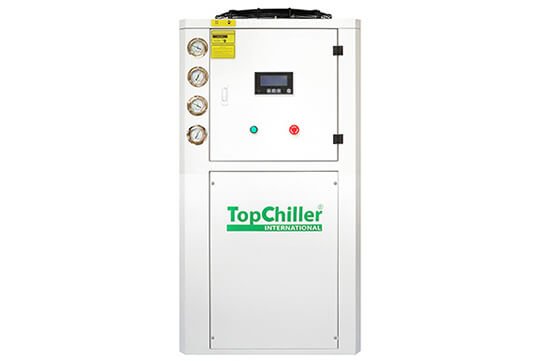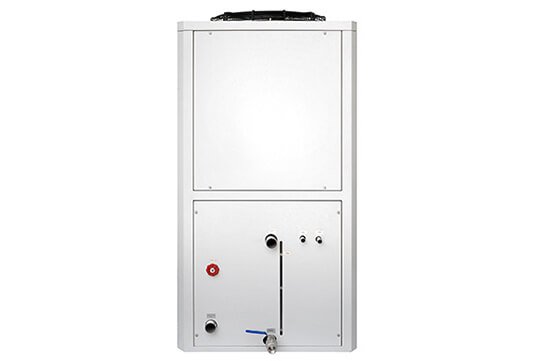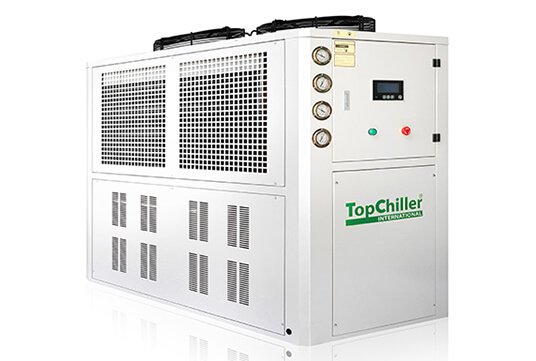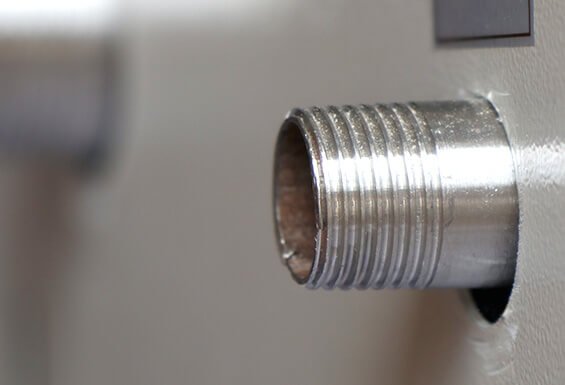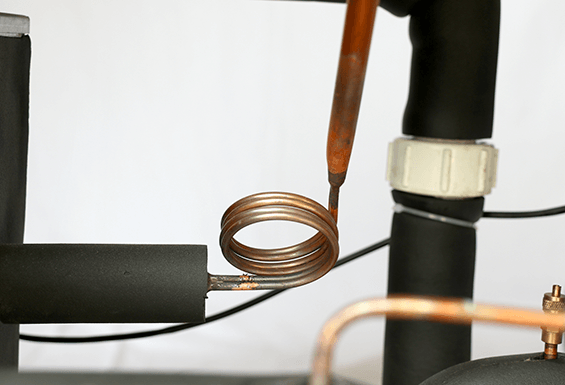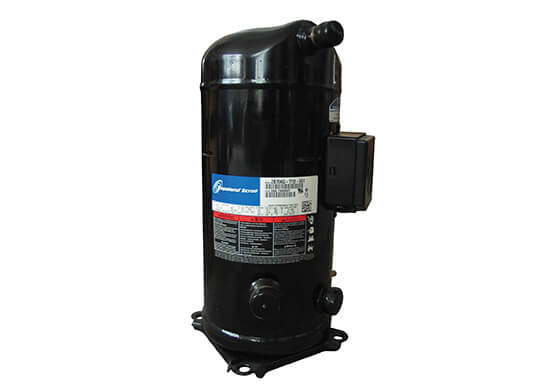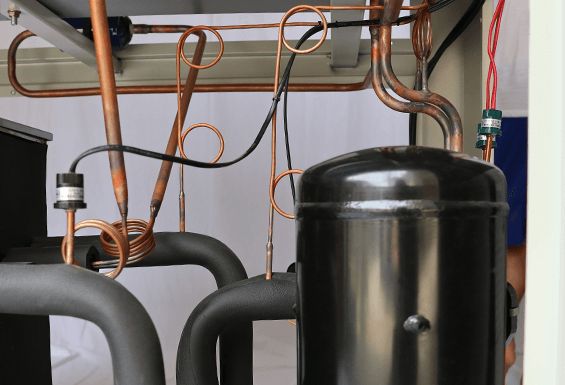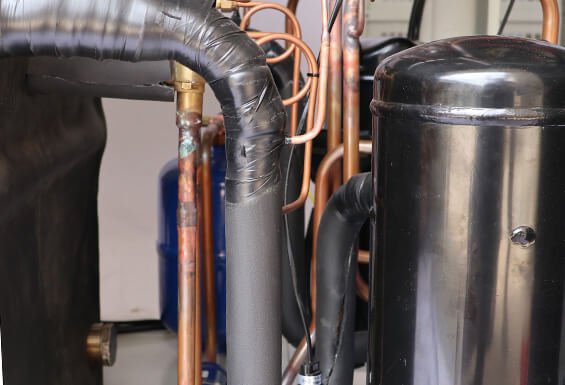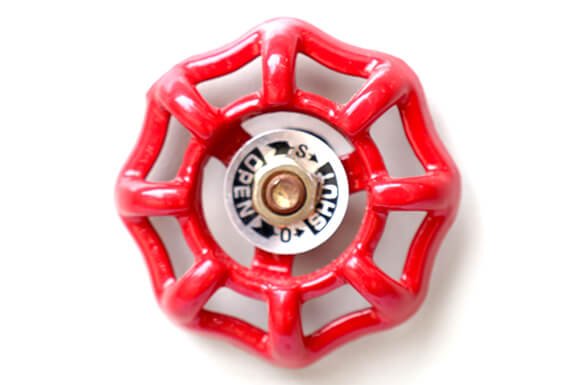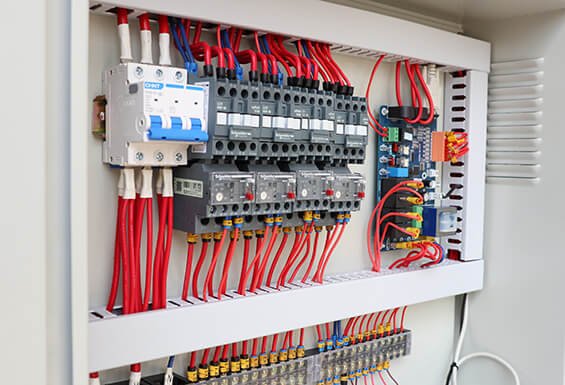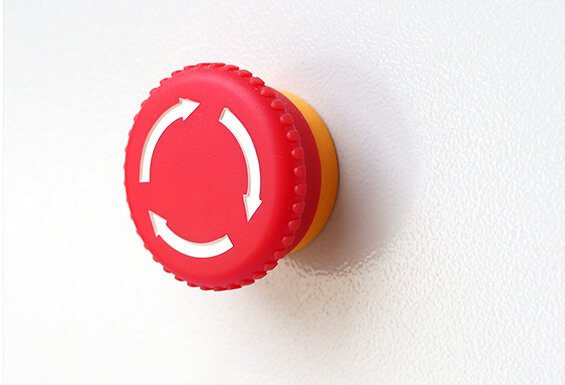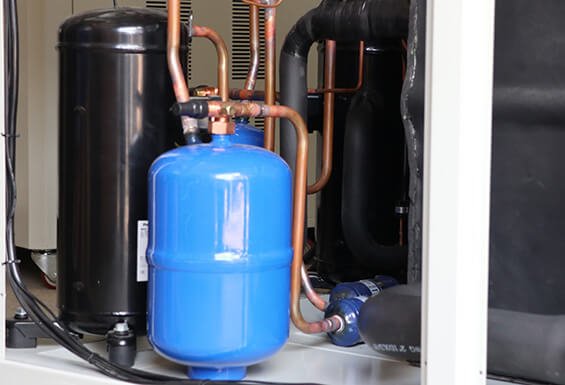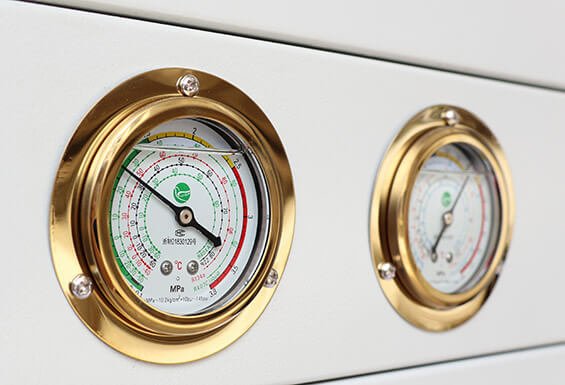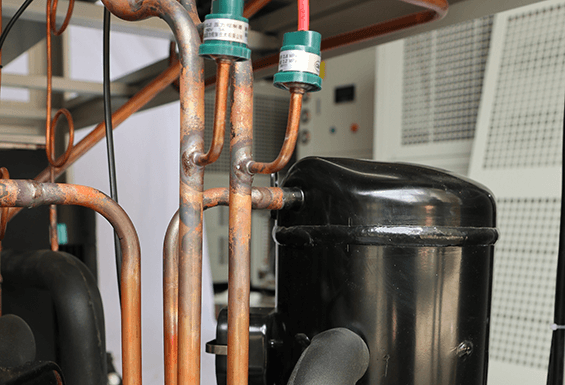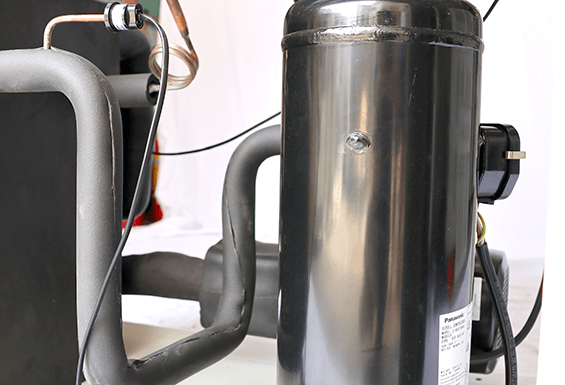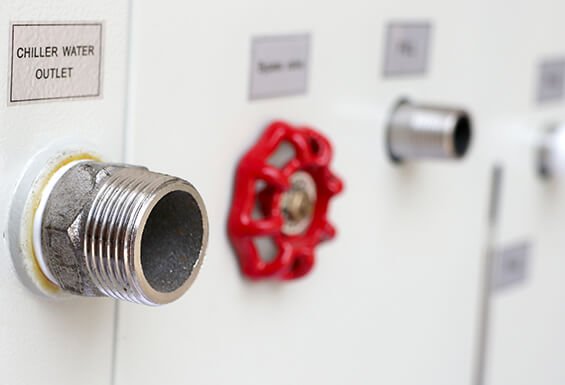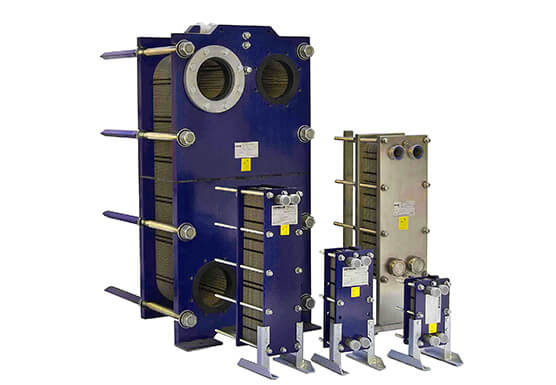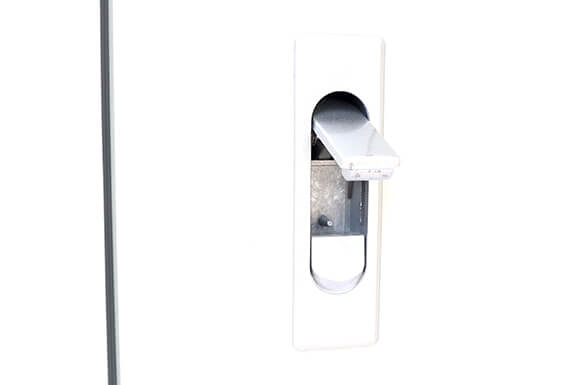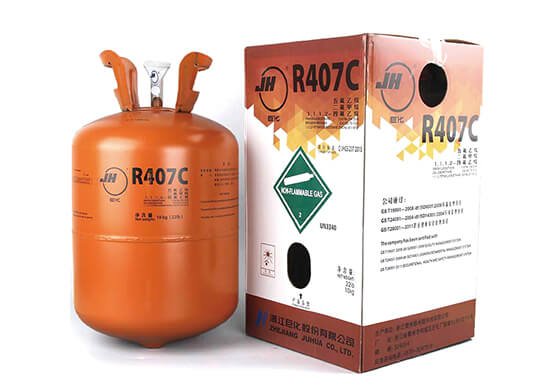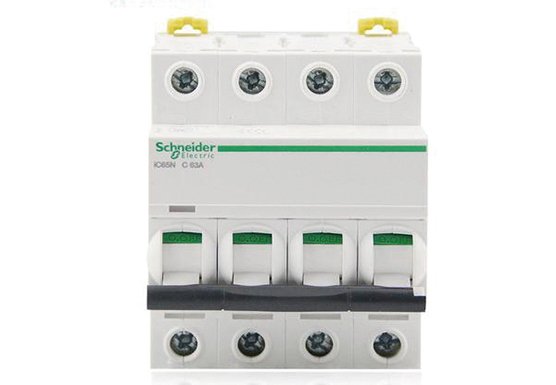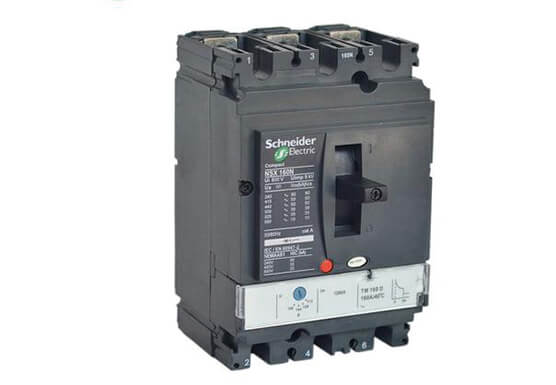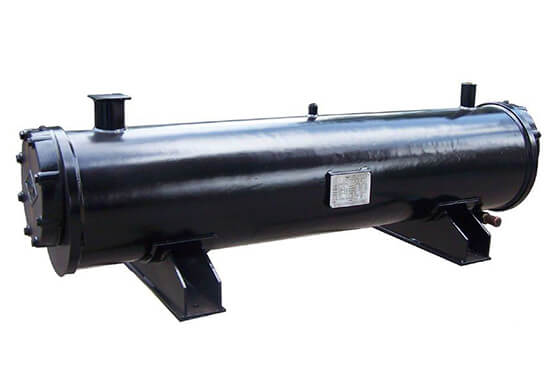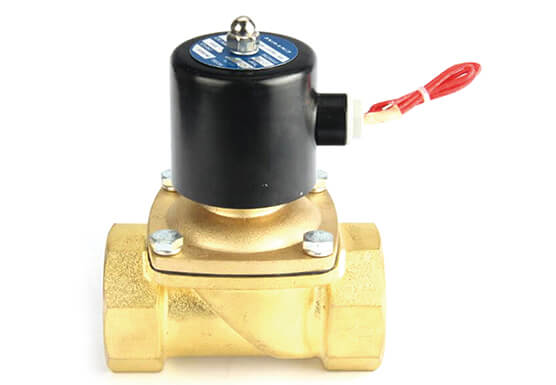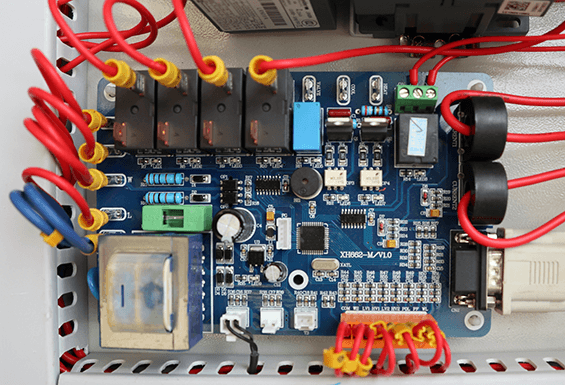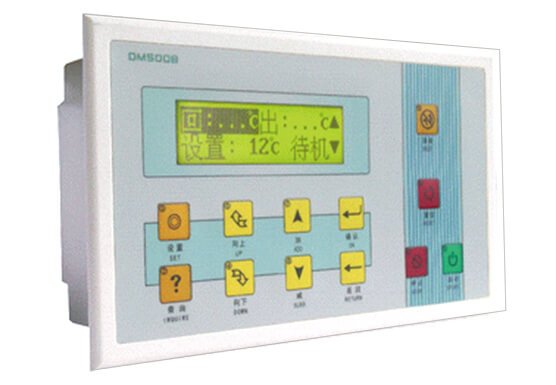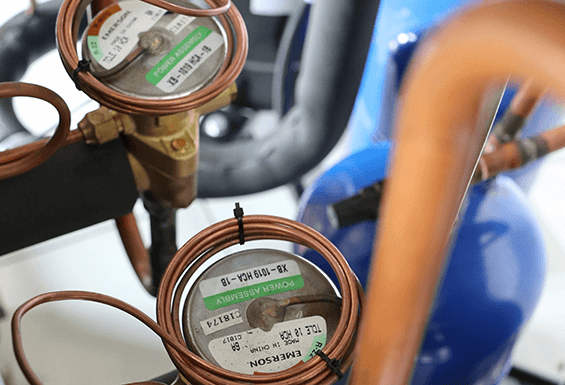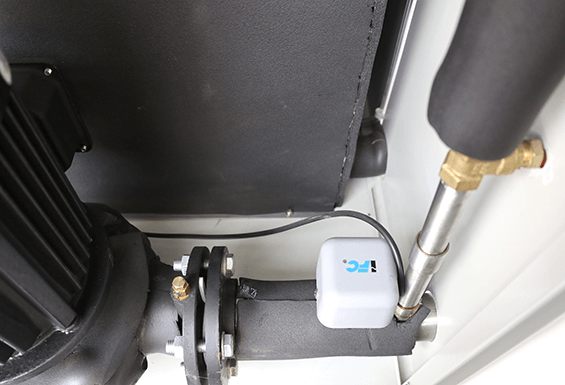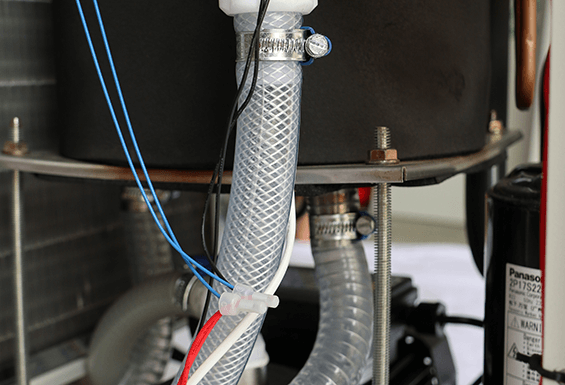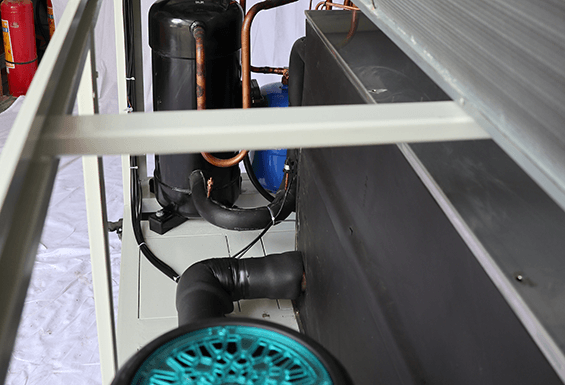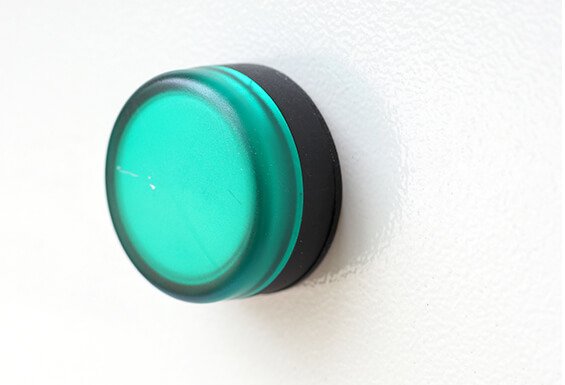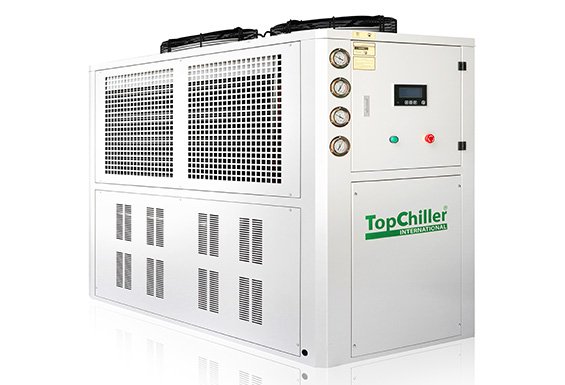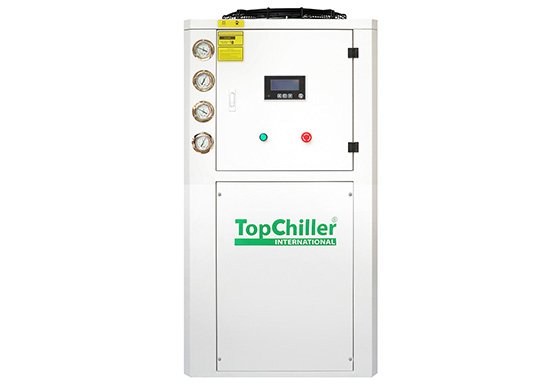TopChiller is Your High Quality Hydraulic Oil Chiller Manufacturer and Supplier In China
- Cooling capacity ranges from 2.5 KW to 68 KW
- Temperature control ranges from 15°C to 30°C
- Top branded efficient scroll compressor
- PHE heat exchanger and filter dryer
- Multiple refrigeration circuits for glycol
- Large-sized condenser coils & air filters
- Full skid mounting & compact design
- Warranty up to 24 months for durability
Your Premier Hydraulic Oil Chiller Manufacturer and Supplier Over 20 Years
Hydraulic Oil Chiller is a cooling machine working on refrigeration principle and provides the cooling effect to hydraulic oil and lubricating oil circulating in processing machines by using chilled water or glycol as coolant.
TopChiller is a professional manufacturer and supplier of highly precise and reliable Hydraulic Oil Chiller in China, focusing on introducing innovative and custom-oriented systems in the construction of high-quality chilling units.
For over twenty years of superb experience, TopChiller has established its position as a pioneer in the global world by customizing Hydraulic Oil Chiller as per clients’ requirements with reputed credentials and appreciation.
Hydraulic Oil Chiller is featured with different components for efficient working as scroll compressor, PHE heat exchanger, filter dryer, sight glass, LCD, PLC temperature controller, evaporator, expansion valves, cooling fan, digital thermostat, and air filters.
TopChiller designed Hydraulic Oil Chiller has its outstanding benefits for oil containing processing machines as given below:
- Hydraulic Oil Chiller prevents the hydraulic machines from oil heating damages by providing the chilling effect configured by use of cooling tower by passing it over the heat exchanger that efficiently absorbs heat from processing oil.
- During hydraulic machine processing, a high amount of heat is produced. A high level of temperature decreases the viscosity of oil causing leakage and machine component damage. So Hydraulic Oil Chiller maintains the viscosity of oil by using PLC-based controlled and thermostat.
- TopChiller engineered Hydraulic Oil Chiller is featured by 3D CAD software for exact placement of unit components for easy approach and compact design for easy installation.
- Hydraulic Oil Chiller is featured with air filters and large-sized condenser coils ensuring the clearance of refrigerant circulating inside the unit and large-sized coils prevent the unit from heat load damages during heat dissipation.
Hydraulic Oil Chiller is used to dissipate heat from different industrial applications as given below:
Hydraulic cutting, turning, metal cutting, lubrication, shearing, hydroforming, broaching, EDM, milling, CNC machines, CNC lathe, honing, water jet jumps, quenching, drilling, grinding, extrusion and padder, etc.
Are you pondering to find the best optimal solution for cooling oil processing machines?
Are you desiring to find the best Hydraulic Oil Chiller manufacturing company in China for getting insights and suggestions for your business development?
Yes, you are on an exact lane. TopChiller is an appreciated company that steps ahead to assist customers except for buying guide.
No need to hesitate. Commence a talk with TopChiller personnel and trained staff for getting details about every aspect of Hydraulic Oil Chiller as working, customization, installation, or any other ambiguity you may have.
Our team will certainly help our clients to customize a Hydraulic Oil Chiller at suitable charges.
General Description:
Hydraulic Oil Chiller is an outstanding featured cooling device mediated to perform the trouble-free operation in a hostile industrial environment. It works on the refrigeration principle for ideally releasing the heat from lubricating and hydraulic oils of processing machines.
Hydraulic Oil Chiller designed by TopChiller maintains precise oil temperature comprising some essential components as:
Scroll/screw compressor, PHE/Shell and tube type evaporator, condenser unit, and expansion valve make refrigeration cycle. Digital thermostat, microprocessor temperature controller, High/low-pressure switches are its safety components.
TopChiller has manufactured Hydraulic Oil Chiller for heat dissipation from a vast number of industrial applications as CNC machines, broaching machines, electroplating industry, honing, milling, metal cutting, and injection molding machines, extrusion, factory furnaces, and plasma spray machines, etc.
If you want the durable performance of your oil processing machines, make sure to install a steadfast working Hydraulic Oil Chiller offered by TopChiller.
TopChiller is a world-leading manufacturer and supplier intended to make innovations in its entire models of Hydraulic Oil Chiller by considering customers’ industrial needs.
So contact us to get guidelines and your order confirmation at affordable rates.
TopChiller has assured its status by offering the quality and credibility of its products under its leveraged experience of more than twenty years.
Features and Advantages:
Hydraulic Oil Chiller offers outstanding benefits for oil processing machines under its peculiar designing and features as given below:
- It retains the viscosity of hydraulic oil from lower down and protection its leakage in machine components featured by temperature controller and digital thermostat.
- Plate-type heat exchanger assures hydraulic oil cooling by heat exchange with refrigerant and occupies less space to reside stably in a chiller.
- Aluminum fins and copper tubing of condenser ensures protection from corrosion, configuring the final discharge of circulating heat in a refrigeration cycle.
- Hydraulic Oil Chiller Prevents the oil processing machines from oil leaks damages configured by using a glycol/water tank as a coolant for heat discharge from oil supply.
- Compact designed unit is easy to install and move from one position to another featured by caster wheels with lockable brakes.
- Protection of high-temperature production configured by microprocessor-based temperature controller with screen display.
- Data Sheet
- Image Gallery
- Main Parts
- Video
| Hydraulic Oil Chiller Technical Specifications | |||||||||||||||||
| Item Model | AC-0.5A | AC-1A | AC-1.5A | AC-2A | AC-2.5A | AC-3A | AC-4A | AC-5A | AC-6A | AC-8AD | AC-10AD | AC-12AD | AC-15AD | AC-20AD | AC-25AD | AC-30AT | |
| Cooling capacity | Kcal/h 50HZ/60HZ | 1419 | 2451 | 3182 | 4833 | 5848 | 7181 | 9288 | 11988 | 14534 | 18576 | 23994 | 29068 | 38270 | 49966 | 58480 | 74922 |
| 1703 | 2941 | 3784 | 5800 | 7018 | 8617 | 11146 | 14386 | 17441 | 22291 | 28793 | 34882 | 45924 | 59959 | 70176 | 89990 | ||
| KW 50HZ/60HZ | 1.65 | 2.85 | 3.7 | 5.62 | 6.8 | 8.35 | 10.8 | 13.94 | 16.9 | 21.6 | 27.9 | 33.8 | 44.5 | 58.1 | 68 | 87.2 | |
| 1.98 | 3.42 | 4.4 | 6.74 | 8.2 | 10.02 | 12.96 | 16.73 | 20.28 | 25.92 | 33.48 | 40.56 | 53.4 | 69.72 | 81.6 | 104.64 | ||
| Input power | KW | 0.88 | 1.35 | 2 | 2.25 | 2.66 | 3.27 | 4.07 | 5.75 | 6.45 | 8.25 | 11.5 | 12.9 | 17.45 | 21.73 | 25.4 | 33.1 |
| Max Current | A | 5.4 | 8.2 | 12 | 13.6 | 6.6 | 8.2 | 10.1 | 13.8 | 15.5 | 20 | 27.9 | 31.3 | 42.4 | 52.7 | 63.7 | 80.2 |
| Power source | 1PH~220V/3PH~220V/380V 50HZ/60HZ | 3PH~380V/415V/480V~50HZ/60HZ(3PH~200V/220V 50HZ/60HZ) | |||||||||||||||
| Refrigerant | Type | R22/R407C/134a/404A/410A | |||||||||||||||
| Control | Capillary / thermostatic expansion valve | ||||||||||||||||
| Compressor | Type | Hermetic Rotary | Hermetic scroll ( piston ) | ||||||||||||||
| Power(KW) | 0.45 | 0.89 | 1.3 | 1.73 | 2.1 | 2.7 | 3.5 | 4.55 | 5.25 | 3.5×2 | 4.55×2 | 5.25×2 | 7×2 | 8.96×2 | 10.8×2 | 8.96×3 | |
| Condenser | Type | Efficient finned copper tube with aluminum+low noise external rotor fan | |||||||||||||||
| Air flow (m³/h) | 750 | 1000 | 1500 | 2000 | 2500 | 3000 | 4000 | 5000 | 6000 | 8000 | 10000 | 12000 | 15000 | 20000 | 25000 | 30000 | |
| Air blower(KW) | 0.06 | 0.09 | 0.15 | 0.15 | 0.19 | 0.14×2 | 0.14×2 | 0.19×2 | 0.19×2 | 0.25×2 | 0.45×2 | 0.45×2 | 0.6×2 | 0.78×2 | 0.78×2 | 0.42×6 | |
| Evaporator | Type | SS Tank coil / shell and tube type / Plate type heat exchanger | |||||||||||||||
| Chilled water (m³/h) | 0.28 | 0.49 | 0.64 | 0.97 | 1.12 | 1.44 | 1.86 | 2.4 | 2.91 | 3.71 | 4.8 | 5.81 | 7.65 | 10 | 11.69 | 15 | |
| 0.34 | 0.59 | 0.76 | 1.16 | 1.4 | 1.72 | 2.23 | 2.88 | 3.49 | 4.46 | 5.76 | 7 | 9.18 | 11.99 | 14.03 | 18 | ||
| Water tank(L) | 10.6 | 18.3 | 27 | 27 | 50 | 50 | 60 | 60 | 110 | 120 | 200 | 200 | 270 | 350 | 350 | 420 | |
| Inlet/outlet pipe (inch) | 1/2″ | 1/2″ | 1/2″ | 1/2″ | 1″ | 1″ | 1″ | 1″ | 1″ | 1-1/2″ | 2″ | 2″ | 2″ | 2″ | 2-1/2″ | 2-1/2″ | |
| Water pump | Power (kw) | 0.37 | 0.37 | 0.37 | 0.37 | 0.37 | 0.37 | 0.37 | 0.75 | 0.75 | 0.75 | 1.5 | 1.5 | 2.2 | 2.2 | 2.2 | 4 |
| Max lift(m) | 22 | 22 | 22 | 22 | 22 | 22 | 22 | 30 | 30 | 25 | 25 | 25 | 28 | 28 | 28 | 30 | |
| Max flow (m3) | 5.4 | 5.4 | 5.4 | 5.4 | 5.4 | 5.4 | 5.4 | 8.1 | 8.1 | 8.1 | 13.5 | 13.5 | 25.2 | 25.2 | 25.2 | 36 | |
| Safety protection | Compressor inner protection, over current protection, high/low pressure protection, over temperature protection, flow rate protection, phase sequence/phase missing protection, low level coolant protection, anti freezing protection, exhaust overheat protection | ||||||||||||||||
| Dimension | L(mm) | 500 | 560 | 600 | 600 | 720 | 850 | 980 | 1100 | 1180 | 1450 | 1530 | 1530 | 1650 | 1850 | 1900 | 2250 |
| W(mm) | 350 | 420 | 420 | 480 | 550 | 580 | 520 | 580 | 620 | 750 | 750 | 750 | 910 | 1000 | 1050 | 1400 | |
| H(mm) | 600 | 720 | 770 | 910 | 1350 | 1030 | 1170 | 1350 | 1350 | 1500 | 1630 | 1630 | 1740 | 1850 | 1970 | 1950 | |
| Net weight(KG) | 45 | 70 | 85 | 95 | 125 | 150 | 175 | 195 | 220 | 285 | 350 | 370 | 510 | 630 | 820 | 950 | |
| Note: The above specifications are according to the following design conditions: 1, 12℃/7℃.Chilled water inlet/outlet temperature 12℃/7℃. 2, 33℃/38℃.Cooling air inlet/outlet temperature 33℃/38℃. We reserve the right to modify the specification without further notice. | |||||||||||||||||
Why TopChiller is Your Reliable Hydraulic Oil Chiller Manufacturer and Supplier In China?
Hydraulic Oil Chiller-An Ultimate FAQ Guide by TopChiller.
- What is Hydraulic Oil Chiller?
- What are the Key Features of Hydraulic Oil Chiller?
- What are the Main Components of Hydraulic Oil Chiller?
- How Does a Hydraulic Oil Chiller Work?
- What are the Advantages of Using Hydraulic Oil Chiller for your Industry?
- How is Air Cooled Hydraulic Oil Chiller Different from Water Cooled Hydraulic Oil Chiller?
- What are the Applications of Hydraulic Oil Chiller?
- Which Refrigerant is Used for Hydraulic Oil Chiller?
- What is the Temperature Controlling Range of Hydraulic Oil Chiller?
- Which Type of Compressors are Installed in a Hydraulic Oil Chiller?
- Which Accessories are Integrated with Hydraulic Oil Chiller?
- What is the Function of Digital Thermostat of a Hydraulic Oil Chiller?
- Which Type of Heat Exchanger is Used for a Hydraulic Oil Chiller?
- Which Condenser is Used for Heat Dissipation in Hydraulic Oil Chiller?
- Which Problems are Sorted Out by Hydraulic Oil Chiller Caused by Heated Oil?
- How Does a Hydraulic Oil Chiller Maintain the Viscosity of Oil in Hydraulic Machines?
- How is the Processing of Hydraulic Oil Chiller Different from Conventional Method of Oil Cooling?
- How Does the Microprocessor of Hydraulic Oil Chiller Perform its Function?
- How to Size a Hydraulic Oil Chiller for your Applications?
- How to Troubleshoot your Hydraulic Oil Chiller?
What is Hydraulic Oil Chiller?
Hydraulic Oil Chiller is a highly reliable temperature maintenance device that ensures the cooling of hydraulic oils for hydraulic-based machines.
It is furnished with a compact stainless steel body and caster wheels optionally for easy movement of the whole unit. It contains a highly developed refrigeration circuit to dissipate the heat from the oil supply.
Temperature controller and digital thermostat are equipped with it as safety components ensuring durability and reliability to deal with the high-temperature load.
Hydraulic Oil Chiller protects CNC, injection molding and broaching machines, etc., by maintaining the oil viscosity and heat dissipation.

Hydraulic Oil Chiller Designed by TopChiller
What are the Key Features of Hydraulic Oil Chiller?
Hydraulic Oil Chiller is a reliable cooling unit that comes with some basic key features as given below:
- Compact designed and sturdy body of chiller.
- Stainless steel material for the construction of the outer surface of the chiller.
- The powder coating of the whole unit makes it protective from corrosion.
- Shell type or PHE evaporator for heat exchanging.
- Temperature controlling unit with digital display.
- Constant heat dissipation from processing machines.
- Energy-efficient working scroll/screw-type compressors.
- Maintenance of oil temperature for the durability of processing machine irrespective of ambient temperature.
- Integrated HP switches for the protection and safety of compressors.
- Factory mounted pre-wiring and piping for easy installation and maintenance.
- Single/double/multiple refrigeration systems for heat dissipation.
- Air/water-cooled condensers for final heat discharge collected from the system.
- Castor wheels are configured with lockable brakes for easy movement of the whole unit.
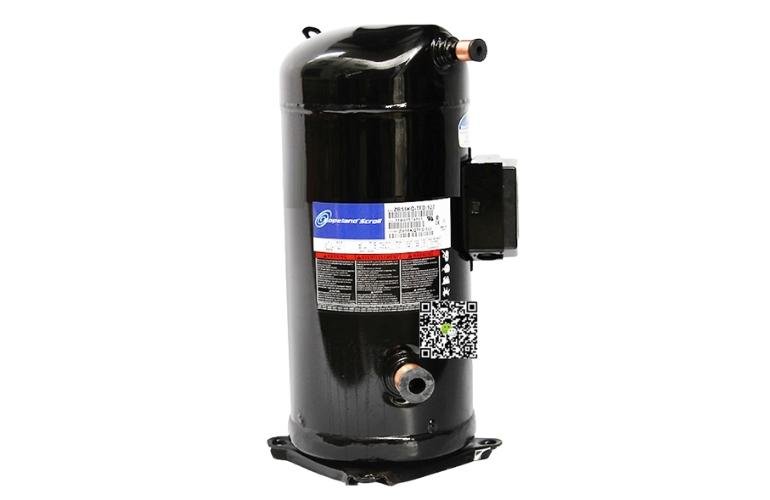
Hydraulic Oil Chiller Compressor
What are the Main Components of Hydraulic Oil Chiller?
Hydraulic Oil Chiller is used to cool the oil of hydraulic machines by connecting it directly with oil pumps or oil supply requiring cooling.
The main components which are involved in the production of the chilling effect are given below:
Compressor
A scroll or screw compressor is integrated to increase the temperature and pressure of the circulating refrigerant. A scroll compressor is highly reliable with its smooth and silent working.
It plays its efficient working by its two rotating parts. One is a fixed scroll, while the other part moves over the other scroll.
Condenser
Both air-cooled condenser and water-cooled condenser can be used for heat liberation collected from heated oil.
The air-cooled condenser discharges heat from refrigerant through air circulated over condenser coils. While the water-cooled condenser releases heat through chilled water circulation coming from the water tank.
Evaporator
Plate type heat exchanger or shell and tube type heat exchanger is installed with Hydraulic Oil Chiller for heat exchange between hot oil and refrigerant. PHE is widely used for heat exchange designed with stainless steel material and brazed joining.
Cooling Fan
The cooling fan protects thermal overloading by releasing temperature and pressure from the refrigerant that leaves the condenser. The phase of refrigerant changes from a gaseous state to a liquid state.
Temperature Controlling Unit
The temperature controlling unit maintains the temperature with a digital screen display. Any temperature change is monitored through an alarm system integrated with the controlling unit.

Hydraulic Oil Chiller Cooling Fan
How Does a Hydraulic Oil Chiller Work?
Most processing machines use hydraulic oils for their normal working and lubrication. During machine processing, the machine oils get heated and may cause a hindrance in the smooth working of hydraulic machines.
So Hydraulic Oil Chiller cools the machine oil in the following way:
Step 1
The water/glycol coolant is installed to cool the heated oil. The hydraulic oil either directly circulates through a chiller or is cooled down by an installed coolant.
Step 2
The glycol/water coolant absorbs heat from hydraulic oil and gets heated. The hot coolant enters inside the plate type/shell or tube-type evaporator for getting cooled back through refrigerant.
Refrigerant and coolant flow in a counter-current manner and exchange heat. The refrigerant absorbs heat from the coolant, and the chilled coolant flows back towards the oil supply/oil pump of processing machines for cooling.
Step 3
After absorbing heat, the heated refrigerant leaves the evaporator with low temperature and pressure and enters the compressor.
Step 4
The scroll or screw compressor receives the incoming vaporized refrigerant and liquefies it by increasing its temperature and pressure. The compressor assists the condenser in condensation of the refrigerant.
The compressed refrigerant discharges out and enters the condenser for finalizing the heat discharge.
Step 5
An air-cooled condenser or water-cooled condenser receives compressed refrigerant that circulates in condenser coils. Air/water circulates over refrigerant, absorbs heat, and condenses it into the liquid phase.
The air dissipates out in the environment. While in the case of water circulation, water moves towards the cooling tower to restore its chilling effect.
Step 6
Expansion valves are also integrated with Hydraulic Oil Chiller to lower the temperature and pressure of the refrigerant before its entrance into the evaporator.
Step 7
After the expansion refrigerant enters the evaporator, the whole process is repeated until the working process may not get completed.
What are the Advantages of Using Hydraulic Oil Chiller for your Industry?
Hydraulic Oil Chiller is a renowned and reliable cooling device for its wide range of industrial applications. It offers an assorted number of advantages for its respective application as given below:
Maintenance of Oil Viscosity
The heat produced by processing machines decreases oils’ viscosity, resulting in oil leakage in different machine parts.
The refrigeration circuit of the Hydraulic Oil Chiller circulates the machine oil configuring the cooling effect with extra heat dissipation.
Durability
High-temperature production in the machine may cause molding and damage to machine components. When a chiller is installed, it makes the constant dissipation of heat from the machine, ensuring longer service life.
Increase in Working Efficiency
Maintenance of recommended temperature by Hydraulic Oil Chiller increase working efficiency and machine productivity. The whole machine is lubricated with oil, assuring the machine’s working at peak efficiency.
Reliability
It assists machine to face lower shutdowns, increase machine uptime, and ultimately reduces the need for machine repairing and maintenance.
How is Air Cooled Hydraulic Oil Chiller Different from Water Cooled Hydraulic Oil Chiller?
Air Cooled Hydraulic Oil Chiller
Air Cooled Hydraulic Oil Chiller is a cooling unit that dissipates the heat from refrigerant through air circulating over condenser coils.
The air-cooled condenser is designed with aluminum fins and copper tubules in which the refrigerant flows. The heated refrigerant enters with high pressure and temperature.
Ambient air over condensing coils absorbs heat from refrigerant when it circulates in coils.
The condensed refrigerant moves toward the evaporator to complete the refrigeration cycle. While air directly discharges out in the environment.
Water Cooled Hydraulic Oil Chiller
When environmental air is very corrosive and dusty, and ambient temperature greater than 55˚C, the water-cooled condenser is preferred to integrate with chiller.
A water-cooled condenser consists of tube-in-tube coils. Refrigerant enters these coils after compression through the compressor.
Chilled water also circulates in tubing over condenser coils. After dissipating heat from the refrigerant, the water moves towards the cooling tank to cool back again.
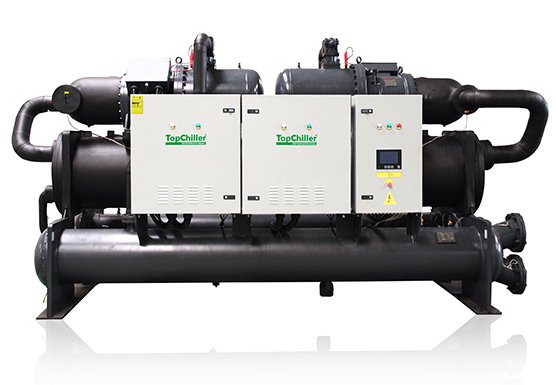
Water Cooled Hydraulic Oil Chiller
What are the Applications of Hydraulic Oil Chiller?
A Hydraulic Oil Chiller is widely used for an assorted number of applications requiring oil cooling that is used for processing of machines as given below:
- Milling
- Holes Drilling
- Injection Molding Machines
- Extrusion
- Honing
- Welding Engineering
- Grinding
- Electroplating Industry
- Factory Furnaces
- Broaching
- Gear Hobbing
- Blow Molding Machines
- Mercerize
- Hydroforming
- Plasma Spray Machines
- Metal Cutting
- Deep Drawing
- Turning
- Induction Hardening Machine
- Spindle Cooling
- Drying
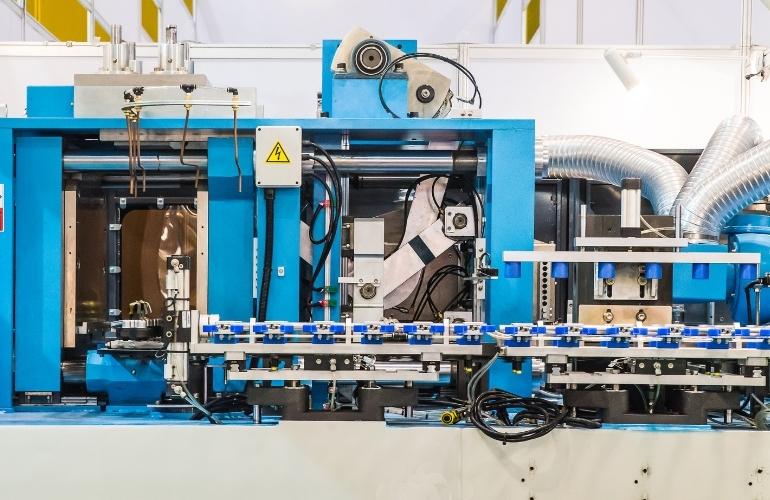
Applications of Hydraulic Oil Chiller
Which Refrigerant is Used for Hydraulic Oil Chiller?
A refrigerant is a chemical compound that is mostly available in the liquid state and can readily absorb heat from a system.
For heat dissipation from a system, refrigerant is also installed in Hydraulic Oil Chiller. The R134A, refrigerant, R404, R410A, and R407C refrigerant can be used optionally for efficient heat absorption from hydraulic oil.
Refrigerant is the essential component of the refrigeration cycle that mediates the overall processing of the chiller.
Refrigerant circulates heat in the refrigeration cycle by changing its phase and finally discharges heat from the system.
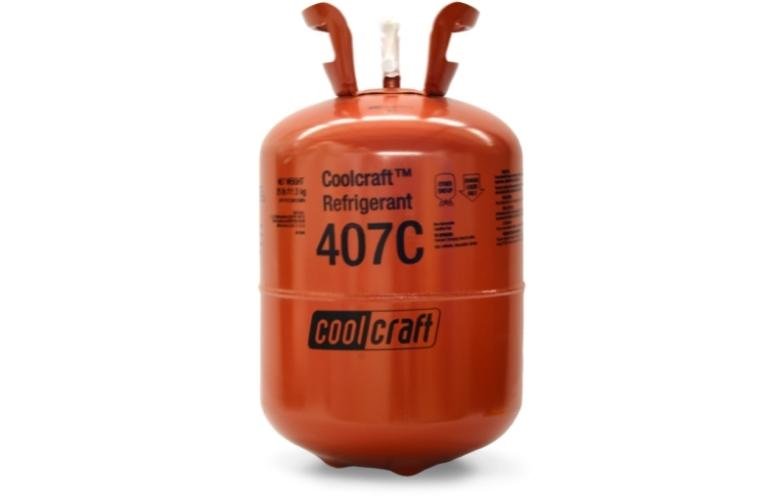
Hydraulic Oil Chiller Refrigerant
What is the Temperature Controlling Range of Hydraulic Oil Chiller?
Hydraulic Oil Chiller ensures the cooling of hydraulic oils by dissipating the heat produced by machine tools while working.
Its ambient temperature controlling range is 10˚C to 50˚C. Its cooling capacity ranges from 1.75KW to 50KW.
Some hydraulic-based machines use oils that get heated with time, cause a change in machine characteristics and ultimately make it useless for further processing.
The Hydraulic Oil Chiller is configured to bear the high heat load with its specific temperature controlling range. So it feasibly discharges heat from hydraulic oils.
Which Type of Compressors are Installed in a Hydraulic Oil Chiller?
A compressor is an integral unit of the refrigeration cycle that puts compression over refrigerant and increases its pressure to assist the condensation of refrigerant in the condenser.
Two types of compressors are being used for reliable and energy-efficient working of the Hydraulic Oil Chiller as given below:
1-Scroll Compressor
A scroll compressor is a highly effective and noise-free working unit that reduces power consumption and other costs under its simple design. The scroll compressor consists of two rotating parts.
One scrolling unit is fixed while the other rotates over the scroll compressor’s fixed part, ensuring noise-free working.
The optimized compressor is specially designed for a hydraulic chiller to bear the load easily.
2-Screw Compressor
The screw compressor also consists of two rotating spiral screws. It compresses the incoming refrigerant efficiently by positive displacement rotary movement of screws.
Screw compressor has replaced reciprocating compressors requiring a little volume of compressing gas, ensuring no volumetric loss of refrigerant.
Chiller Models Based on Number of Compressors
Based on workload, three different models of Hydraulic Oil Chiller are available:
- A chiller containing one compressor is called a single compressor series.
- The chiller featured with compressors and two refrigeration cycles is known as the dual compressor series.
- While the chiller model containing multiple compressors is called a multiple compressor series.
Which Accessories are Integrated with Hydraulic Oil Chiller?
For safe, protective, and efficient working, different accessories options are integrated with Hydraulic Oil Chiller as given below:
- High/Low Refrigerant Pressure Controlling Switches
- Fan Speed Controlling Unit
- Antifreeze Thermostat
- Inline Filter
- Oil Pressure and Flow Switches
- Rotating Wheels With Brakes
- Alarms and Control Signals
- Electrical Control Box
- Polyurethane Air Filter

Hydraulic Oil Chiller Flow Switch
What is the Function of Digital Thermostat of a Hydraulic Oil Chiller?
The digital thermostat is a temperature regulating unit with a digital display screen. The thermostat is set with ‘ON’ and ‘OF’ switches based on required cooling adjustments.
A digital thermostat regulates the high/low temperature of the oil.
Alarms and oil temperature sensors are configured with a thermostat that rings when a change occurs in oil temperature.
Which Type of Heat Exchanger is Used for a Hydraulic Oil Chiller?
Two types of heat exchangers/evaporators can be used for heat exchange between refrigerant and coolant in Hydraulic Oil Chiller oil as given below:
Shell and Tube Type Heat Exchanger
Shell and tube-type heat exchanger consists of a shell and a bundle of tubules inside the shell.
The refrigerant flows inside the tubules. At the same time, the other fluid, either coolant or direct oil supply, flows over tubules for heat exchange.
The refrigerant absorbs heat from the oil and converts it into refrigerant gas. At the same time, the coolant moves back towards the working machine.
The copper-designed shell and tube type is resistive to corrosion but occupies an ample space as compared to PHE.
PHE (Plate Heat Exchanger)
The brazed plate heat exchanger is an efficiently working evaporator by configuring the turbulence flow of fluid. The plate-type heat exchanger consists of the plate in which firmly impregnated tubules.
One fluid flows in plates while the other fluid is in tubules. The heat gets exchanged between fluids from hot to cold fluid.
The evaporated refrigerant leaves the heat exchangers to recover its liquid phase. At the same time, the other fluid or coolant turns back to the system.
PHE occupies less space than shell and tube-type heat exchangers with its reliable design and working efficiency.
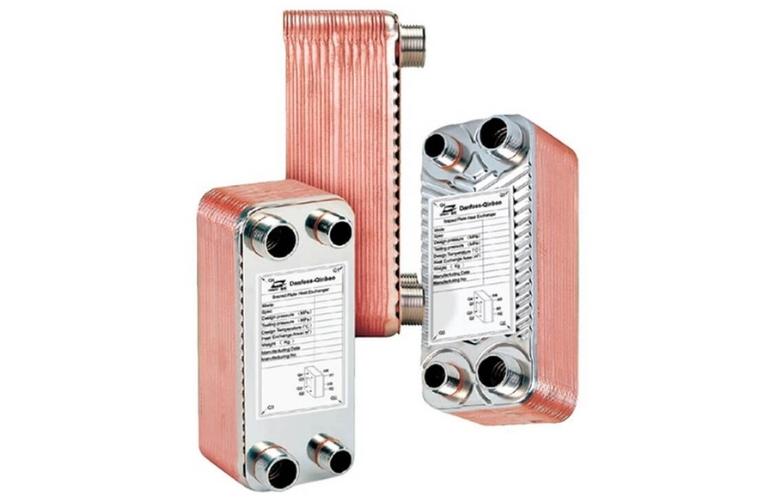
Hydraulic Oil Chiller Plate Heat Exchanger
Which Condenser is Used for Heat Dissipation in Hydraulic Oil Chiller?
Two types of condensers are used for heat dissipation from Hydraulic Oil Chiller that is given below:
Air Cooled Condenser
When there is low ambient temperature, and the environment is clean from dust and rusting factors, the air-cooled condenser is preferred to use.
The air-cooled condenser consists of copper tubing with aluminum fins ensuring protection from corrosion.
Air circulates over condenser coils containing compressed and vaporized refrigerant.
Air absorbs the heat from the refrigerant to cool it down for the continuation of the refrigeration cycle and spreads in the surrounding environment ensuring refrigerant cooling.
Water Cooled Condenser
In case of high ambient temperature, the water-cooled condenser is installed for efficient heat release from the system.
It consists of a tube-in-tube system where the refrigerant and chilled water circulate. Heat exchanges between refrigerant and water.
Refrigerant gets cooled after heat liberation and leaves the condenser to enter the evaporator for heat discharge.
While water with absorbed heat flows back in the cooling tank for recovering its cooling from coming with the next refrigeration cycle.
Which Problems are Sorted Out by Hydraulic Oil Chiller Caused by Heated Oil?
Some of the hydraulic based machinery is configured with hydraulic oil that may get heated and cause different problems as:
- When the machine works, its gears and headstocks release heat that lowers oil’s viscosity, causing its leakage in the hydraulic device.
- The degradation process of oil also increases, hence requiring oil change before the due date of an oil
- The machine tools may damage due to defects caused by high temperature and increase the costs for extra consumption of oil.
Hydraulic Oil Chiller sort out these problems in the following way:
- These problems faced by processing machines are sorted out using a Hydraulic Oil Chiller. It is attached directly to the oil supply. The heated oil is circulated through the chiller for heat dissipation.
- The glycol/water coolant is installed that circulates an overheated oil supply in the system and returns to the evaporator after heat absorption.
- The evaporator cools down the coolant again for continuously circulating in the system for heat discharging and maintaining the temperature at a specific level.
- In this way, the hydraulic oil remains cool, ensuring the durability and efficient working of hydraulic system-based machines.
How Does a Hydraulic Oil Chiller Maintain the Viscosity of Oil in Hydraulic Machines?
Hydraulic oil used in machines heats up periodically because the machine releases heat while operating. The dissipating heat lowers the viscosity of the oil.
Oil becomes thin with decreased viscosity, resulting in internal oil leakage with different machine parts damages.
The heat produced by heat stock and gear causes the spindle to heat up and deviate from its working position.
Hydraulic Oil Chiller maintains oil’s viscosity by dissipating heat produced during machine processing.
The refrigeration circuit of the chiller cools down the hydraulic oil resulting in the maintenance of oil viscosity.
The coolant from the chiller maintains the machine’s temperature, prevents the oil from degradation, and ensures the longer service life of the machine.

Hydraulic Oil Chiller Refrigeration Cycle
How is the Processing of Hydraulic Oil Chiller Different from Conventional Method of Oil Cooling?
Conventional Method of Oil Cooling
In the conventional method, the machine’s hydraulic oil is cooled down by using a cooling tower in the heat exchanger. The cooling tower discharges the heat from incoming heated oil in the heat exchanger.
But the drawback of this conventional method is that the temperature of water in the cooling tower does not remain constant. With time oil temperature deviates, resulting in a decrease the working efficiency.
The heat exchanger gets clogged due to a change in water quality. So the heat does not dissipate completely from hydraulic oil, affecting the working efficiency of working machines.
In the conventional method, a shell and tube-type heat exchanger is used to cool the oil circulating over the refrigerant in exchanger tubes.
Hydraulic Oil Chiller for Oil Cooling
Thus for better machine performance, Hydraulic Oil Chiller is being used that constantly maintains the viscosity and temperature of processing machines. It is featured with a gear pump that mediates the oil supply towards the chiller from the powerpack.
Oil is processed through a refrigeration circuit. Heat is exchanged between the refrigerant and heated oil. After heat discharge, the chilled oil is transferred back into the powerpack.
The brazed plate heat exchanger is being used to ensure rapid and efficient cooling of the oil. PHE is compact, covering less space than shell and tube-type heat exchangers.
The PHE provides the turbulent flow between oil and refrigerant counter-current flow, ensuring efficient heat dissipation.
How Does the Microprocessor of Hydraulic Oil Chiller Perform its Function?
The microprocessor is a specialized part of the Hydraulic Oil Chiller installed for automation control.
The microprocessor performs its function through a proactive controlled strategy and ensures the safety of the whole unit by making simple diagnostics.
The factory programmed the microprocessor to regulate the automation system according to the application requirements and features.
The microprocessor is user-friendly to answer questions typed in English. The microprocessor provides options in English for controlling cooling and other features of the Hydraulic Oil Chiller.
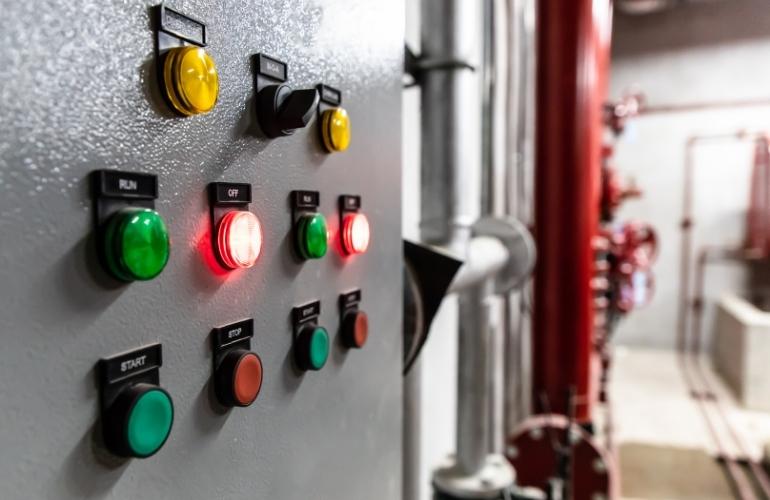
Hydraulic Oil Chiller Controller
How to Size a Hydraulic Oil Chiller for your Applications?
A Hydraulic Oil Chiller is used for a vast number of industrial applications requiring heat dissipation produced during machine working. Different applications need this chiller of different sizes and types.
It can be sized for an application by keeping in view some critical points as given below:
Ambient Temperature
If the ambient temperature of the environment where the Hydraulic Oil Chiller has to work is less than 55˚C, then select the chiller with an air-cooled condenser.
While if the temperature goes above 50˚C and the environment is with dusty air, then make sure to select the chiller containing water-cooled condenser.
Heat Load
Make sure to calculate the heat load of your application and then select the Hydraulic Oil Chiller according to the cooling capacity and temperature, controlling a range of chiller.
Cost
Consider your budget while choosing the chiller for your application. Always select the chiller that would be suitable and comparable to your budget.
How to Troubleshoot your Hydraulic Oil Chiller?
Even after regular maintenance and inspection, Hydraulic Oil Chiller can face some problems and degradation in performance with time.
The problems can be evaporator clogging, refrigerant leakage, reduction in the compressor’s working efficiency, etc.
Some common issues can be troubleshot of a Hydraulic Oil Chiller in the following way:
Chiller is Not Running
If the chiller has stopped running, check out the circuit breaker, electric wires as well as controlled switches.
Inspect the problem, adjust the refrigerant temperature/ pressure and turn ON the chiller.
Low Cooling of Coolant
Check and inspect the cooling of the coolant that discharged out from the evaporator. If cooling does not come close to on set point, the problem would be due to clogging/freezing of the evaporator.
To troubleshoot the problem, use the anti-freezing agent or replace the evaporator with a new one in case of clogging.
The Ringing of Temperature Sensor Alarm
If a high-temperature sensor alarm runs while Hydraulic Oil Chiller is processing, it will be due to a high heating load.
Maintains the heating load at the normal range for smooth flow of chiller.
The Ringing of Low Liquid Alarm
If the low liquid alarm is on while working, the problem would be a reduction in refrigerant level or circulation system.
Troubleshoot this problem by reinstalling the refrigeration or regulating the circulation system at a set point.
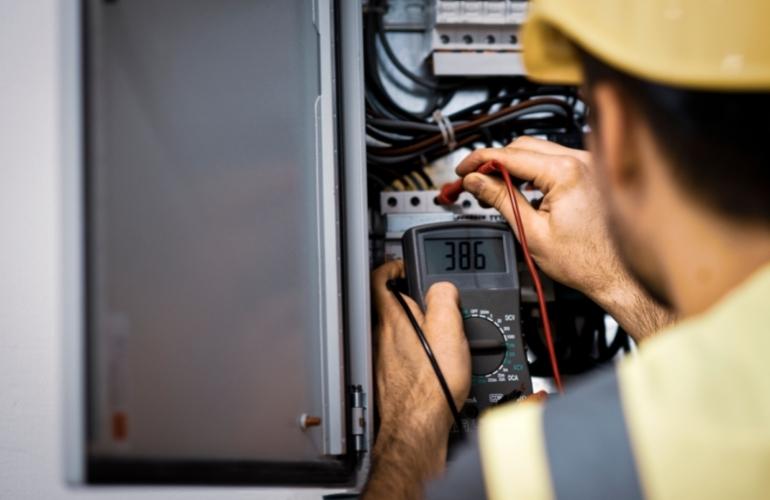
Hydraulic Oil Chiller Troubleshooting
